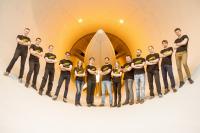Hyperloop – Transport Revolution in the Hands of Students
Can Polish scientists compete with specialists from wealthier and more developed countries? Of course! Polish students from the Hyper Poland University Team are the proof. The team has qualified for the final stage of the Hyperloop one-person pod construction competition. They are one of four European teams, the only one from Central and Eastern Europe.
Hyperloop is an ultra-modern mean of transport. It combines the flexibility of a car, speed of a plane, and comfort of a train. The vehicle's pod moves in a reduced-pressure tube. It achieves this using magnetic levitation. Thanks to these properties, travelling from Warsaw to Wrocław could take just 23 minutes. In addition to the vehicles and tubes in which the vehicle would travel, the project also involves building stations situated in city centres – not on the outskirts, like airports, which significantly increases plane travel time. The author of Hyperloop is Elon Musk, the owner of SpaceX.
Works on this modern solution have also been underway in Poland. The Hyper Poland team, consisting mostly of people related to the Warsaw University of Technology and the Wrocław University of Science and Technology, has been preparing the target concept for Hyperloop. It also promotes Hyper Poland University Team, who have been focusing on participating in the competition organised by SpaceX. “The student group is independent from Hyper Poland”, emphasises Krzysztof Tabiszewski, the founder of Hyper Poland.
An Extraordinary Pod
The Hyperloop Pod Competition will take place at the end of August 2017 in California. 24 teams from the entire world, who qualified for the finals, will be testing their pods on a dedicated track. Its length is approx. 1.5 kilometre, while its diameter is 2 metres. "The purpose of the competition is to achieve the highest speed, and to safely come to a halt", explains Paweł Radziszewski, student at the WUT's Faculty of Power and Aeronautical Engineering, leader of the Hyper Poland University Team. "Creating a braking system that provides this is probably the biggest challenge because the track is short and speed is high. The maximum speed that we want to reach on this track is approx. 430 km/h.
The pod will weigh 290 kg, with a fairly small body (370 x 88 x 104 cm). It will have an internal drive (four electric motors with 435 horsepower) and levitating systems (which will raise the vehicle above the track, thus allowing it to move that quickly). The pod will be built using light materials typically used in aerospace engineering – i.e. aluminium alloys and carbon fibres. All to make the vehicle levitate.
“Air resistance at cruising speed will be equal to 3.5 kg”, says Paweł Radziszewski. “Compared to the target speed, it's low”.
The pod will not transport a person during tests. The competition rules require only space for a mannequin inside.
Support Badly Needed
To build a prototype pod and go to the competition in the United States, the team needs at least PLN 150 thousand. A collection of such an amount is a large challenge; therefore, the team decided to collect money at a crowdfunding website: https://odpalprojekt.pl/hyperpoland. The "HYPER POLAND – FOLLOW US WITH THE SPEED OF SOUND!" fundraiser will end on 24 April 2017. “We're helping the student group to raise necessary funds because we care about the project's growth in Poland”, says Krzysztof Tabiszewski. “We are convinced that, thanks to participation in the competition, the students will gain many valuable experiences required to build the target Hyperloop system in the future”.
“Our goal is to test our Polish solutions in the Hyperloop technology at the only Hyperloop track currently in existence”, says Paweł Radziszewski. “It's a unique chance for Polish technology, and each zloty given for the construction of the prototype takes us one step closer to winning at the Hyperloop Pod Competition”.
The Hyper Poland University Team consists of 25 people. They represent six science clubs. The team is made up of:
– students of the Warsaw University of Technology: Paweł Radziszewski (Team Leader), Serafin Bachman (Electronics Lead), Hubert Kamiński (Marketing Team), Łukasz Klimaszewski (Electronics Engineer), Jakub Kośnik (Electronics Engineer), Tomasz Kublin (Electromagnetic Systems Lead), Piotr Niedziółka (Marketing Team), Łukasz Niewiński (Aerodynamics Engineer), Łukasz Ordyszewski (Electromagnetic Systems Engineer), Joanna Patejuk (Composite Structures Engineer), Wojciech Sadowski (Pod Dynamics Engineer; Electronics Engineer), Mikołaj Siwek (Mechanical Engineer; Brake System), Karol Skrzypczyński (Electronics Engineer), Paweł Sobczak (Material Engineer), Natalia Strawa (Pod Dynamics Lead), Grzegorz Sykut (Mechanical Engineer; Frame Structure), Tomasz Szpartaluk-Kozak (FEM & Heat Transfer Engineer), Grzegorz Świątek (Mechanical Engineer; Brake System), Michał Tymosiuk (Electronics Engineer), Katarzyna Zawadzka (Mechanical Lead; Pod Suspension), Mateusz Żmudziński (Electromagnetic Systems Engineer),
– students of the Wrocław University of Science and Technology: Tomasz Dziubak (Electrical System Engineer) and Wojtek Pawlak (Electrical System Engineer),
– students of the Warsaw University of Technology: Karolina Dzik (Marketing Lead) and Marta Kośnik (Marketing).
The students are supervised by Professor Janusz Piechna, PhD. From the Division of Mechanics of the Faculty of Power and Aeronautical Engineering.
Agnieszka Kapela
Office for Promotion and Information








